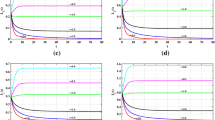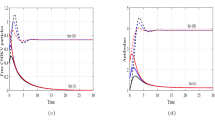Abstract
A generalized model of intra-host CHIKV infection with two routes of infection has been proposed. In a first step, the basic reproduction number \(\mathscr {R}_0\) was calculated using the next-generation matrix method and the local and global stability analyses of the steady states are carried out using the Lyapunov method. It is proven that the CHIKV-free steady state \(\bar{E}\) is globally asymptotically stable when \(\mathscr {R}_0\le 1,\) and the infected steady state \(E^*\) is globally asymptotically stable when \(\mathscr {R}_0>1\). In a second step, we applied an optimal strategy via the antibodies’ flow rate in order to optimize infected compartment and to maximize the uninfected one. For this, we formulated a nonlinear optimal control problem. Existence of the optimal solution was discussed and characterized using an adjoint variables. Thus, an algorithm based on competitive Gauss–Seidel-like implicit difference method was applied in order to resolve the optimality system. The theoretical results are confirmed by some numerical simulations.





Similar content being viewed by others
References
Carvalho SA, da Silva SO, Charret IDC (2019) Mathematical modeling of dengue epidemic: control methods and vaccination strategies. Theory Biosci 138(2):223–239
Diekmann O, Heesterbeek JA, Metz JA (1990) On the definition and the computation of the basic reproduction ratio \(\mathscr {R}_0\) in models for infectious diseases in heterogeneous populations. J Math Biol 28(4):365–382
El Hajji M (2018) How can inter-specific interferences explain coexistence or confirm the competitive exclusion principle in a chemostat. Int J Biomath 11(8):1850111
El Hajji M (2019a) Boundedness and asymptotic stability of nonlinear Volterra integro-differential equations using Lyapunov functional. J King Saud Univ Sci 31(4):1516–1521
El Hajji M (2019b) Optimal control of an “SIR” epidemic model in a chemostat using some suitable protein doses. J Adv Math Comput Sci 30(6):1–15
El Hajji M, Chorfi N, Jleli M (2015) Mathematical model for a membrane bioreactor process. Electron J Differ Equ 2015(315):1–7
El Hajji M, Chorfi N, Jleli M (2017) Mathematical modelling and analysis for a three-tiered microbial food web in a chemostat. Electron J Differ Equ 2017(255):1–13
Elaiw AM, Alade TO, Alsulami SM (2018a) Analysis of latent CHIKV dynamics models with general incidence rate and time delays. J Biol Dyn 12:700–730
Elaiw AM, Alade TO, Alsulami SM (2018b) Analysis of within-host CHIKV dynamics models with general incidence rate. Int J Biomath 11:25
Elaiw AM, Almalki SE, Hobiny AD (2019a) Global dynamics of humoral immunity Chikungunya virus with two routes of infection and Holling type-II. J Math Comput Sci 19:65–73
Elaiw AM, Almalki SE, Hobiny AD (2019b) Stability of CHIKV infection models with CHIKV-monocyte and infected-monocyte saturated incidences. AIP Adv 9:025308
Elaiw AM, Almalki SE, Hobiny AD (2020) Global dynamics of Chikungunya virus with two routes of infection. J Comput Anal Appl 28(3):481–490
Fleming WH, Rishel RW (1975) Deterministic and stochastic optimal control. Springer, New York
Lai X, Zou X (2014) Modelling HIV-1 virus dynamics with both virus-to-cell infection and cell-to-cell transmission. SIAM J Appl Math 74:898–917
Lai X, Zou X (2015) Modeling cell-to-cell spread of HIV-1 with logistic target cell growth. J Math Anal Appl 426:563–584
LaSalle JP (1976) The stability of dynamical systems. SIAM, Philadelphia
Lenhart S, Workman JT (2007) Optimal control applied to biological models. Chapman and Hall, London
Li F, Wang J (2015) Analysis of an HIV infection model with logistic target cell growth and cell-to-cell transmission. Chaos Solitons and Fractals 81:136–145
Long Kristin M, Heise Mark T (2015) Protective and pathogenic responses to Chikungunya virus infection. Curr Trop Med Rep 2(1):13–21
Pontryagin LS, Boltyanskii VG, Gamkrelidze RV, Mishchenko EF (1962) The mathematical theory of optimal processes. Wiley, New York
Van den Driessche P, Watmough J (2002) Reproduction numbers and sub-threshold endemic equilibria for compartmental models of disease transmission. Math Biosci 180:29–48
Wang Y, Liu X (2017) Stability and Hopf bifurcation of a within-host Chikungunya virus infection model with two delays. Math Comput Simul 138:31–48
Wang J, Lang J, Zou X (2017) Analysis of an age structured HIV infection model with virus-to-cell infection and cell-to-cell transmission. Nonlinear Anal Real World Appl 34:75–96
Acknowledgements
The author would like to thank the editors and the anonymous reviewers whose invaluable comments and suggestions have greatly improved this manuscript.
Author information
Authors and Affiliations
Corresponding author
Ethics declarations
Conflict of interest
The author declare that they have no conflict of interest.
Additional information
Publisher's Note
Springer Nature remains neutral with regard to jurisdictional claims in published maps and institutional affiliations.
Appendix: Appropriated scheme for the control problem
Appendix: Appropriated scheme for the control problem
Consider a subdivision of the time interval [0, T] as follows: \([0,T] =\displaystyle \bigcup\nolimits_{n=0}^{N-1} [t_n, t_{n+1}], \quad t_n = n \mathrm{d}t, \quad \mathrm{d}t = T/N\). Let \(S^n, I^n, P^n, A^n, \lambda ^n_1, \lambda ^n_2, \lambda ^n_3, \lambda ^n_4\) and \(\Lambda _2^n\) be an approximation of S(t), I(t), P(t), A(t), \(\lambda _1(t)\), \(\lambda _2(t), \lambda _3(t), \lambda _4(t)\) and the control \(\Lambda _2(t)\) at the time \(t_n\). \(S^0, I^0, P^0, A^0\), \(\lambda ^0_1, \lambda ^0_2, \lambda ^0_3, \lambda ^0_4\) and \(\Lambda _2^0\) as the state and adjoint variables and the controls at initial time. \(S^N, I^N, P^N, A^N\), \(\lambda ^N_1, \lambda ^N_2, \lambda ^N_3, \lambda ^N_4\) and \(\Lambda _2^N\) as the state and adjoint variables and the control at final time T. In order to resolve the state system, a created improving the Gauss–Seidel-like implicit finite-difference method was applied. For the adjoint system, a first-order backward difference is applied and then the following appropriated scheme was adapted:
Hence, the following algorithm will be applied under MATLAB software to solve the optimality system and then one deduces the optimal control.

Rights and permissions
About this article
Cite this article
El Hajji, M. Modelling and optimal control for Chikungunya disease. Theory Biosci. 140, 27–44 (2021). https://doi.org/10.1007/s12064-020-00324-4
Received:
Accepted:
Published:
Issue Date:
DOI: https://doi.org/10.1007/s12064-020-00324-4




